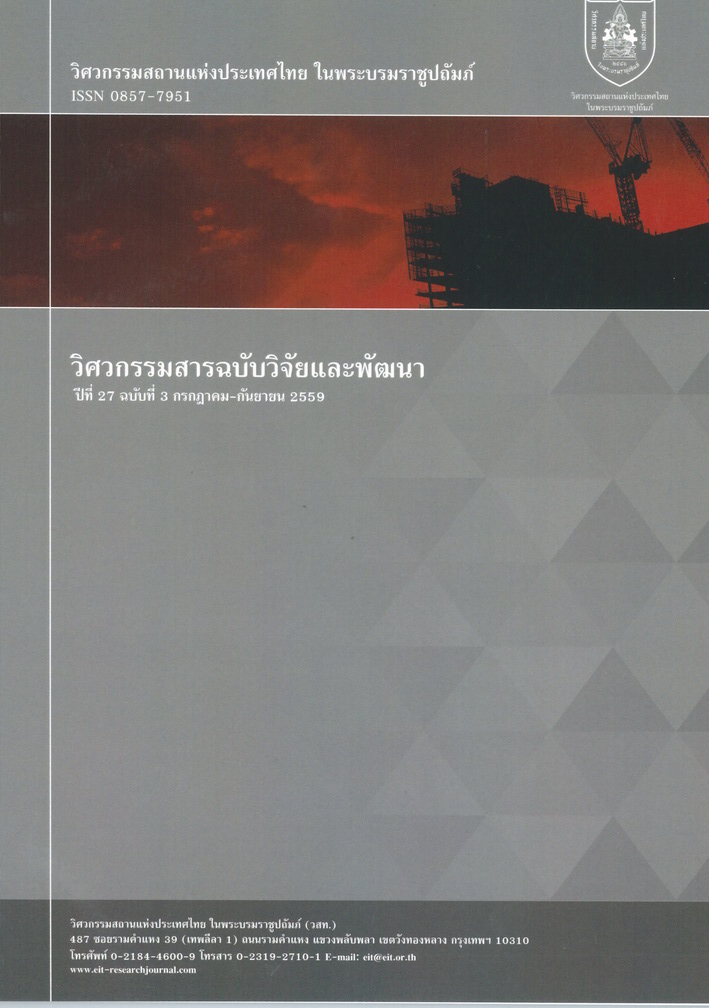EFFECT OF MILLING PROCESS PARAMETER ON CHIP MORPHOLOGY AND CUTTING EDGE WEAR IN FACE MILLING PROCESS OF HARDFACING WELD METAL ON JIS-S50C CARBON STEEL SURFACE
Main Article Content
Abstract
งานวิจัยนี้มีจุดประสงค์ในการศึกษาความเป็นไปได้ในการกัดปาดหน้าโลหะเชื่อมพอกแข็งบนพื้นผิวเหล็กกล้าคาร์บอน JIS-S50C และรายงานผลในรูปของโครงสร้างจุลภาค ลักษณะของเศษการกัด และความหยาบพื้นผิว ผลการทดลองโดยสรุปมีดังต่อไปนี้ ใน การกัดผิวหน้าพบเศษการกัดแบบไม่ต่อเนื่อง โลหะเชื่อมแบบไม่มีชั้นรองพื้นทำให้เกิดเศษการกัดที่ยาวและหนากว่าโลหะเชื่อมแบบ รองพื้น การสึกหรอของคมตัดมีค่าเพิ่มขึ้นเมื่อความยาวตัดเพิ่มขึ้น การเกิดการสึกหรอสูงสุดของคมตัดมีค่า 850 um พบได้เมื่อ ทำการกัดผิวหน้าโลหะเชื่อมแบบไม่รองพื้นในสภาวะเปียก และมีค่าสูงกว่าโลหะฐาน 4 เท่า ความแข็งที่สูงของโลหะเชื่อมแบบไม่มี การสร้างชั้นรองพื้นให้ค่าการสึกหรอสูงกว่าโลหะเชื่อมแบบมีการสร้างชั้นรองพื้น เมื่อเปรียบเทียบกับเกณฑ์ยอมรับ 0.2 mm. ค่าที่ ได้มีค่าสูงกว่าเกณฑ์และเครื่องมือตัดนี้อาจไม่เหมาะสมในการเลือกใช้ เปรียบเทียบการสึกหรอของคมตัดในสภาวะเปียกและแห้ง พบว่า การกัดในสภาวะแห้งให้ค่าการสึกหรอต่ำกว่าเนื่องจากสภาวะเปียกทำให้เกิดหยดสารหล่อเย็นที่ปริมาณมากและไม่สามารถแทรกซึมเข้าสู่ผิวสัมผัสระหว่างชิ้นงานกับคมตัดเพื่อลดอุณหภูมิการตัดได้และส่งผลทำให้เกิดการสึกหรอที่รุนแรงขึ้นได้
This research aimed to feasibility study of the face-milling performance on the hardfacing weld metal on JIS-S50C carbon steel and reported in term of microstructure, chip characteristic, wear, and surface roughness. The summarized results are as follows. Discontinuous chips were found in all machining conditions. No buffering weld metal produced longer and thicker chip than that of the buffering weld metal. The flank wear of the cutting tool edge was increased when the cutting length of the test specimen was increased. The maximum wear of 850 um could be found when the no-buffering weld metal in wet condition was investigated and was about 4 times higher than the base metal. High hardness of the no-buffering weld metal produced higher flank wear of the cutting tool edge than that of the buffering weld metal. When compared to wear acceptability criteria 0.2 mm., it seemed not to satisfy for the selection of this current tool material for machining the current weld metal. Comparing the wear of the cutting tool edge in wet and dry condition, it found that the dry condition produced smaller flank wear than that of the wet condition. This was caused by the wet condition that contained larger coolant oil droplets could not penetrate into the chip-tool interface for decreasing the cutting temperature and produces severe wear in the cutting tool.
Article Details
The published articles are copyright of the Engineering Journal of Research and Development, The Engineering Institute of Thailand Under H.M. The King's Patronage (EIT).

